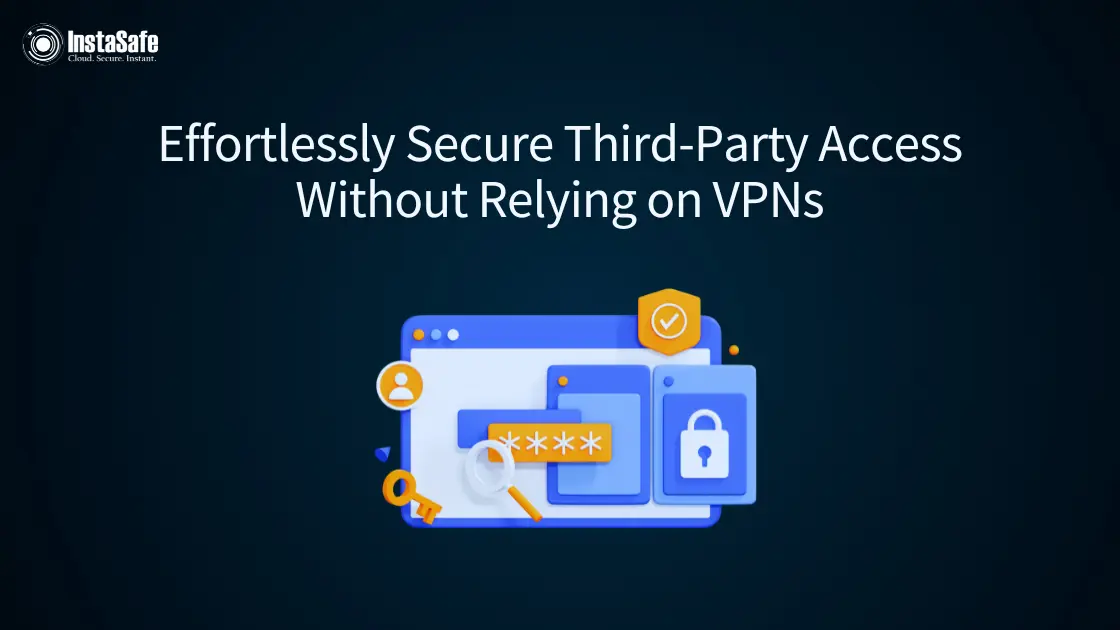Effortlessly Secure Third-Party Access Without Relying on VPNs

Organisations today need to provide secure third-party access to their systems and data for vendors, contractors and partners. For years, Virtual Private Networks (VPNs) were the go-to solution, but they come with significant drawbacks.
Modern businesses are discovering VPN alternatives that offer better security, scalability and user experience. This article explores why traditional VPNs fall short of remote access security and presents newer technologies that enable secure access without VPN dependencies.
Common Challenges with VPNs for Third-Party Access
Security Risks
VPNs create security vulnerabilities when used for third-party access. Once connected, users often gain broad network access beyond what they actually need, violating the principle of least privilege.
This expanded attack surface creates opportunities for malicious actors. If a third party's VPN credentials are compromised, attackers can access your entire network.
Scalability and Management Challenges
Managing VPN infrastructure for third-party access quickly becomes unwieldy as your partner ecosystem grows. Each new connection requires manual configuration, creating administrative bottlenecks.
IT teams must constantly update VPN clients, manage server infrastructure and troubleshoot connection issues. Further, remote access security becomes increasingly complex, with multiple third parties, each requiring different access levels.
User Experience Issues
Third parties using VPNs frequently encounter frustrating connection problems, which slow down their work and create productivity barriers. Providing secure access without a VPN offers much simpler user experiences.
Moreover, VPN clients are often complex to install and configure, leading to support tickets and delays. Connection speed issues are also common, especially when users are geographically distant from VPN servers.
Regulatory Compliance
VPNs make compliance with data protection regulations challenging when managing third-party relationships. The all-or-nothing access model complicates audit trails and makes it difficult to demonstrate who accessed what resources.
Remote access security requirements in regulations like GDPR, HIPAA and PCI-DSS demand granular controls that traditional VPNs struggle to provide.
Modern VPN Alternatives
Zero Trust Network Access (ZTNA)
ZTNA delivers secure third-party access by following the "never trust, always verify" principle. Unlike VPNs, ZTNA provides precise application-level access instead of network-level access.
Users are continually authenticated and authorised based on identity, device health and behaviour. This VPN alternative creates secure micro-perimeters around specific applications rather than exposing the entire network.
Secure Access Service Edge (SASE)
It combines WAN capabilities with network security functions to support secure access without VPN for distributed workforces and third parties. This cloud-based architecture integrates security services like threat prevention, data loss prevention and web filtering with networking capabilities.
SASE provides consistent, secure third-party access regardless of location or device. By combining networking and security into a single cloud service, SASE makes management easier while still giving all users, including third parties, strong security limits for online access.
Unified Endpoint Management (UEM)
UEM solutions enhance secure third-party access by managing and securing all devices that connect to your resources. Unlike VPNs that focus only on network connections, UEM ensures devices meet security requirements before granting access.
This VPN alternative enables organisations to enforce security policies on third-party devices, monitor compliance and remotely wipe sensitive data if necessary. UEM complements other security measures by addressing the endpoint security aspect of remote access security, ensuring third-party devices don't become weak links.
Cloud-Based Firewalls and Software-Defined Perimeters (SDP)
Cloud firewalls and SDPs provide secure access without VPN by creating invisible infrastructure that only authorised users can see and access. These solutions implement the "dark cloud" concept, where resources are hidden from the public internet.
Third parties can only discover and connect to authorised resources after strict verification of their identity and security posture. This VPN alternative dramatically reduces the attack surface while maintaining seamless, secure third-party access. Simply put, SDPs deliver the perfect balance of strong remote access security and straightforward user experience.
Benefits of Securing Third-Party Access Without VPNs
Enhanced Security
Modern VPN alternatives implement granular access controls and continuous verification, dramatically reducing attack surfaces. These solutions enforce the principle of least privilege for all third parties.
Secure third-party access solutions provide deeper visibility into user activities and better threat detection capabilities than traditional VPNs can offer.
Improved Scalability and Flexibility
Remote access security without VPNs scales effortlessly as your business grows and third-party relationships evolve. Further, cloud-based solutions eliminate hardware constraints and can quickly accommodate new users.
Secure access without VPN provides location-independent connectivity that adapts to changing work environments and business needs without infrastructure limitations.
Simplified Management
Centralised policy management replaces complex VPN configurations when implementing secure third-party access solutions. IT teams spend less time troubleshooting connection issues and more time on strategic initiatives.
Further, modern VPN alternatives provide automated deployment, updates and scaling, reducing administrative overhead and eliminating tedious manual processes required by traditional VPN systems.
Better User Experience
Third parties enjoy frictionless access without complicated VPN clients or connection procedures. Remote access security improves with simplified authentication methods like single sign-on and biometrics.
Secure access without a VPN means consistent performance regardless of location, eliminating the latency issues commonly experienced with traditional VPNs.
Implementing Secure Third-Party Access
Steps to Transition from VPNs to Modern Solutions
- Audit current third-party access needs and identify specific applications and resources each third party requires
- Select appropriate VPN alternatives based on your security requirements and business needs.
- Develop access policies based on user identity, device security and least privilege principles.
- Deploy secure third-party access solutions in phases, starting with less critical systems.
- Implement strong identity verification methods and multi-factor authentication.
- Create a migration timeline for each third party and provide clear communications.
- Train both internal teams and third parties on new remote access security procedures.
- Run parallel systems temporarily to ensure a smooth transition.
- Monitor and fine-tune secure access without VPN solutions as you gain experience.
Best Practices for Secure Third-Party Access
- Implement continuous monitoring of all third-party activities and establish normal behaviour baselines.
- Create different access levels based on third-party roles, never granting more access than necessary.
- Require secure, company-managed endpoints or ensure third-party devices meet security standards.
- Set up automated alerts for suspicious behaviours, failed login attempts and policy violations.
- Establish clear offboarding procedures to immediately revoke access when relationships end.
- Regularly review and update secure third-party access policies as your business evolves.
- Conduct periodic security assessments of your VPN alternatives implementation.
- Maintain detailed logs of all remote access security events for compliance and auditing.
- Implement time-based access restrictions for sensitive resources when appropriate.
- Develop an incident response plan specific to third-party access issues.
Understanding the Role of UEM in Enabling ZTNA
- UEM serves as the foundation for effective, secure third-party access by ensuring all connecting devices meet security requirements.
- Verifies device compliance and health status before ZTNA grants resource access, creating a powerful security layer.
- Enables organisations to enforce encryption, patch levels and security configurations on third-party devices.
- Ensures remote access security starts at the endpoint level before network connection attempts.
- Provides continuous monitoring that alerts security teams to potential device-related risks early.
- Automates security policy enforcement across all endpoints accessing your resources.
- Manages the entire device lifecycle, from enrollment to retirement, for comprehensive security.
- Creates a seamless integration with ZTNA for a complete VPN alternative solution.
- Supports secure access without VPN by focusing on the health and compliance of the connecting device.
Conclusion
Moving beyond traditional VPNs for secure third-party access delivers significant advantages in security, scalability and user experience. By implementing modern VPN alternatives like ZTNA, SASE and SDP organisations can drastically reduce security risks while simplifying management.
Remote access security improves through continuous verification and precise controls. The transition requires careful planning but delivers long-term benefits that far outweigh the initial effort.
Transform how you secure third-party access with Instasafe Zero Trust Network Access (ZTNA). Our solutions deliver application-level access, eliminating broad network exposure risks. Enjoy unmatched scalability, simplified management and compliance with data protection regulations while ensuring productivity through seamless, fast and secure remote access. Choose Instasafe ZTNA!
Frequently Asked Questions (FAQs)
- What is third party access?
Third-party access allows external vendors, contractors or partners to use specific resources within your organisation's network, requiring secure third-party access protocols to protect sensitive data.
- What is the best alternative to a VPN?
Zero Trust Network Access (ZTNA) is a leading VPN alternative that verifies users continuously based on identity, context and behaviour, providing superior remote access security.
- Why is zero trust better than a VPN?
Zero trust improves security by validating every access request regardless of source, eliminating VPN alternatives' network-level trust and applying continuous verification to each resource independently.
- What is an example of a third party?
IT contractors, software vendors and consultant firms are examples of third parties requiring secure access without VPN through identity-based authorisation methods and least-privilege controls.
